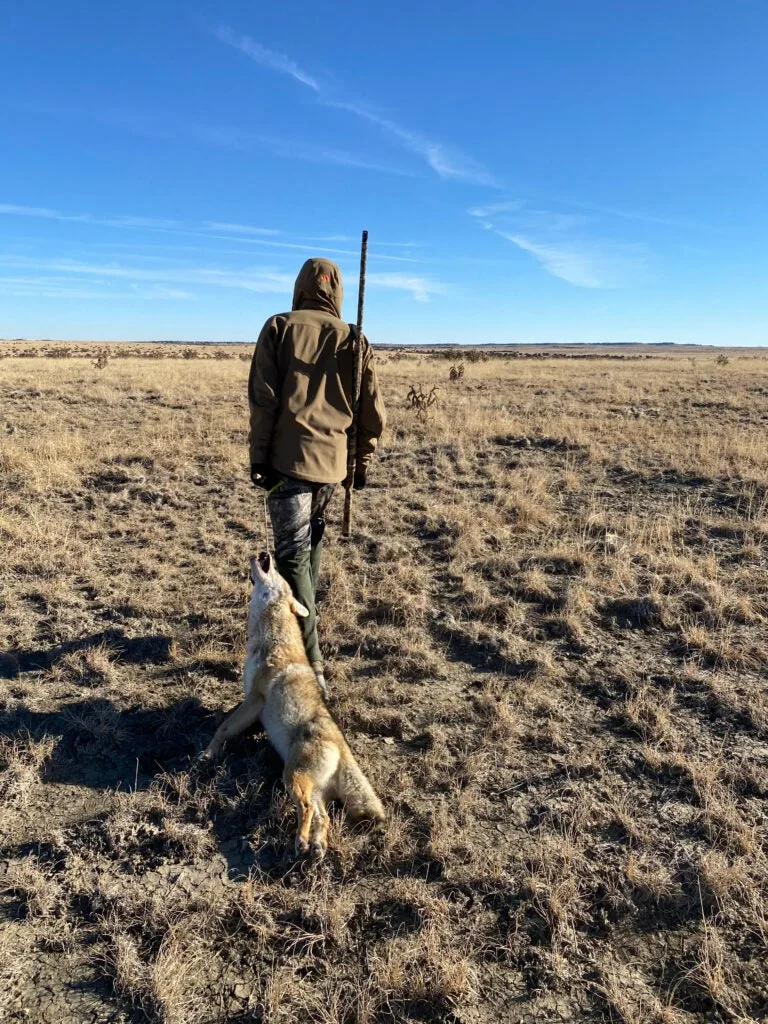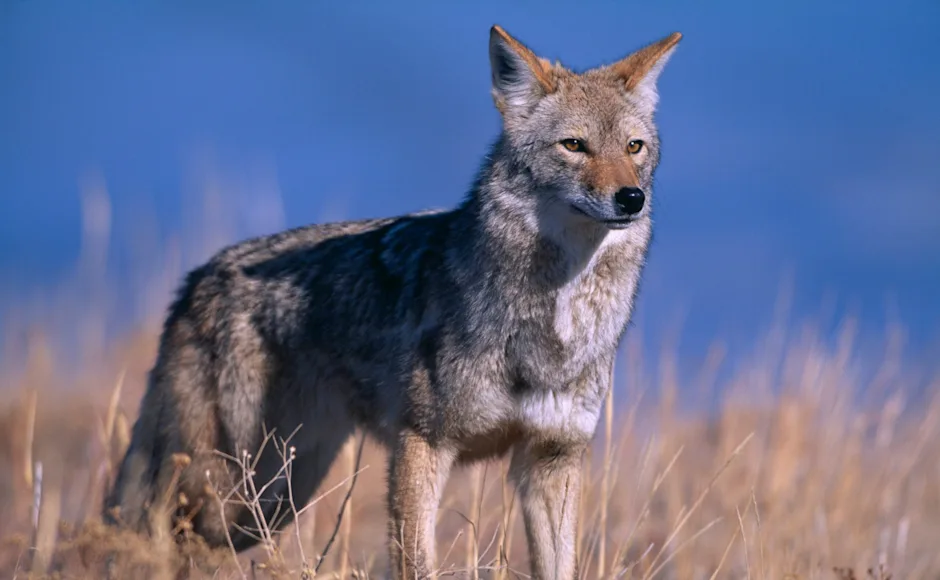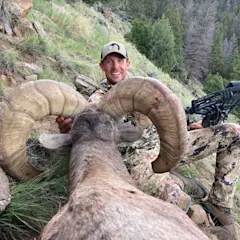_We may earn revenue from the products available on this page and participate in affiliate programs. Learn more ›
_
There’s a window right about now, as November leans more toward December and late fall feels more like winter, when I put my big-game bow down for a while, trade it for a .223 or shotgun, and turn my attention squarely onto coyotes. When it comes to calling dogs into gun range, I don’t think there’s a better time. Pelts are thickening—getting prime for the taking. Young of the year coyotes are highly susceptible to distress calls now, and coyotes young and old are spending more time on their feet hunting for food.
Of course, these are still coyotes we are talking about. They’re never easy to fool, but if you follow these four tips, you’ll have plenty of fur for the stretching board.
1. Before Calling, Find Out What Coyotes Are Eating.

When you know what area coyotes are eating and key in on the sounds their favorite prey, you’ll be in for great hunting. Jace Bauserman
Here’s a trick that should be obvious but that most coyote hunters don’t bother doing—and it can make a huge difference. Before you touch a call, spend some time scouting your area and find out what the local song dogs are eating. This isn’t a difficult task, but you have to pay close attention. For instance, if you see a few dogs sniffing around in a prairie dog town, you know these plump prairie pests are on the menu. If you’re rolling down a two-track road and find some droppings, put on some rubber gloves and investigate. If the droppings are full of feathers, coyotes are keying on birds. If the droppings have deer or pronghorn hair, they’re keying on fawns and will come to a fawn-in-distress call. Don’t just go to your calling grounds, crank up a wounded-rabbit sound, and call it good. I would guess more than 80 percent of coyote callers rely solely on rabbit sounds. As a result, smart coyotes get used to those sounds and avoid them. Match your sounds to the game that’s in the area, and you’ll have more success.
2. Be Patient. Give Each Setup a Full Half Hour.
My 16-year-old son said it best the other day while we were driving up a dirt road on the way to our next calling point. “Dad, I love to call coyotes,” he sad. “But it’s hard to stay focused when they don’t come in the first 5 minutes.”
I have kept extensive records over the years, and I believe after the 12-minute mark, your odds of calling a coyote start to go down a little, but they remain pretty good for longer than that. My rule of thumb this time of year is to stay on stands for 30 minutes. The key is to keep scanning and not start losing faith at the 15-minute mark. During November, food is easier to obtain than it is in late winter, which may cause dogs to be a little less aggressive as they head towards a meal.
Earlier this month, my son and I started calling at one of our money spots at 10 a.m. It’s a large sage flat full of bird life. Over the past three years, we’ve called the area six times, always later in the winter, and killed nine coyotes. All (including some doubles and triples) have come sprinting to a Sparrow-Raspy WP distress sound, and all dogs showed up during the first 5 minutes of each calling session. We’d never called the spot in November before, and this his time it was different. Temperatures were in the upper 50s, and it took precisely 17:28 seconds for a pair of coyotes to wander in. As good as late fall is for calling coyotes, you do have to be a little more patient.
3. Let Coyotes Get Close.

The author’s son hauls a furred-up November dog off the Colorado plains. Jace Bauserman
One of the biggest mistakes I see newbie coyote hunters
make is taking shots that are too long. My goal is to get every coyote as close as possible, and over the years, my crew and I have shot piles of them at less than 5 yards. Our reasoning for getting them so close is twofold: First, it makes for an exciting hunt. Second, cleaning up and sewing a coyote blasted by a shotgun is quick and easy.
When you first spy a coyote coming to your call, read his body language. Get him in your scope, but as long as he’s moving toward you, let him keep coming. It’s typical for approaching coyotes to stop for a few seconds from time to time and scan the area. They are looking for the prey they hear, and if you have a remote that activates a decoy, this is a great time to twirl it. If the dog resumes his course, let him keep coming.
Another excellent tip for getting a coyote to come closer is switching the caller back on for a brief second as the dob is paused and watching. You can stay with the same sound—be sure to lower the volume first—or go with any rodent distress call.
It’s a different story is a coyote sits down on his haunches and freezes like a statue. This body language typically means the dog saw something he doesn’t like, and if he’s in range, you need to take him.
It’s also common for approaching coyotes to try and work downwind. Always know your exact wind direction and speed. If the wind is in your face, the dog will have to work behind you to catch your scent, and chances are good you’ll get him close. If you’re hunting a crosswind, be ready to stop the dog with a bark before he hits your wind.
4. Don’t Play It Loud, for Starters.
People ask me all the time how far I think coyotes can hear a distress call. My answer is: I have no idea, but it’s a hell of a long way. Once, while hunting the open prairie of southeast Colorado, my hunting partner and I spied a coyote bedded in a prairie dog town. His SIG rangefinder told us the dog was 789 yards away. The wind was blowing in our face (away from the dog) at a speed of 7 miles per hour. With the volume on his FoxPro caller set very low, he let the caller emit a few prairie dog distress sounds. The coyote erupted from his bed and came on a string.
Read your landscape and the current wind conditions before turning on your caller. I tell you this because when it comes to volume, more doesn’t always mean better. Wooded river bottoms and rolling cedar canyons won’t let sound travel nearly as far as open country does, but you’ll likely be closer to coyotes when you kick the caller on, so keep the volume in mind. Also, if the wind is pushing over 15 mph, you’ll need to push the volume button up a bit. Still, start with the volume low, even when the wind is blowing or when hunting wide-open spaces. Too many times, I’ve walked in on a bedded dog I didn’t know was there, blasted the volume, and watched him tuck tail and run away.
Most important, get out there. November is a great time to call coyotes, and don’t forget that those pelts are worth some green. Skinning, stretching, fleshing, and sewing pelts does take some work, but it’s a gratifying process and, at the very least, will help pay for your addiction.






